PSEB Class 10 Physics Solutions For Chapter 2 The Human Eye And The Colourful World
The Human Eye
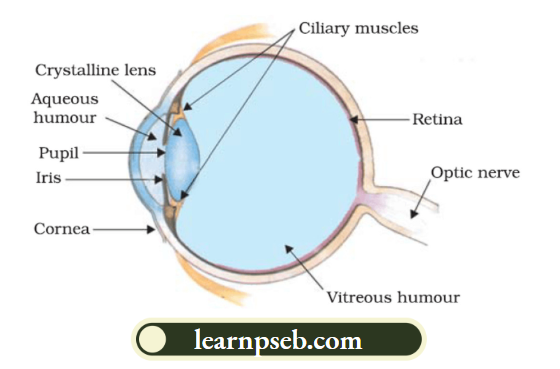
Points To Remember About the Human Eye
- The human eyeball is approximately spherical in shape. Its diameter is about 2.3 cm.
- Eyes are located in eye sockets in the skull.
- The human eye consists of the following parts:
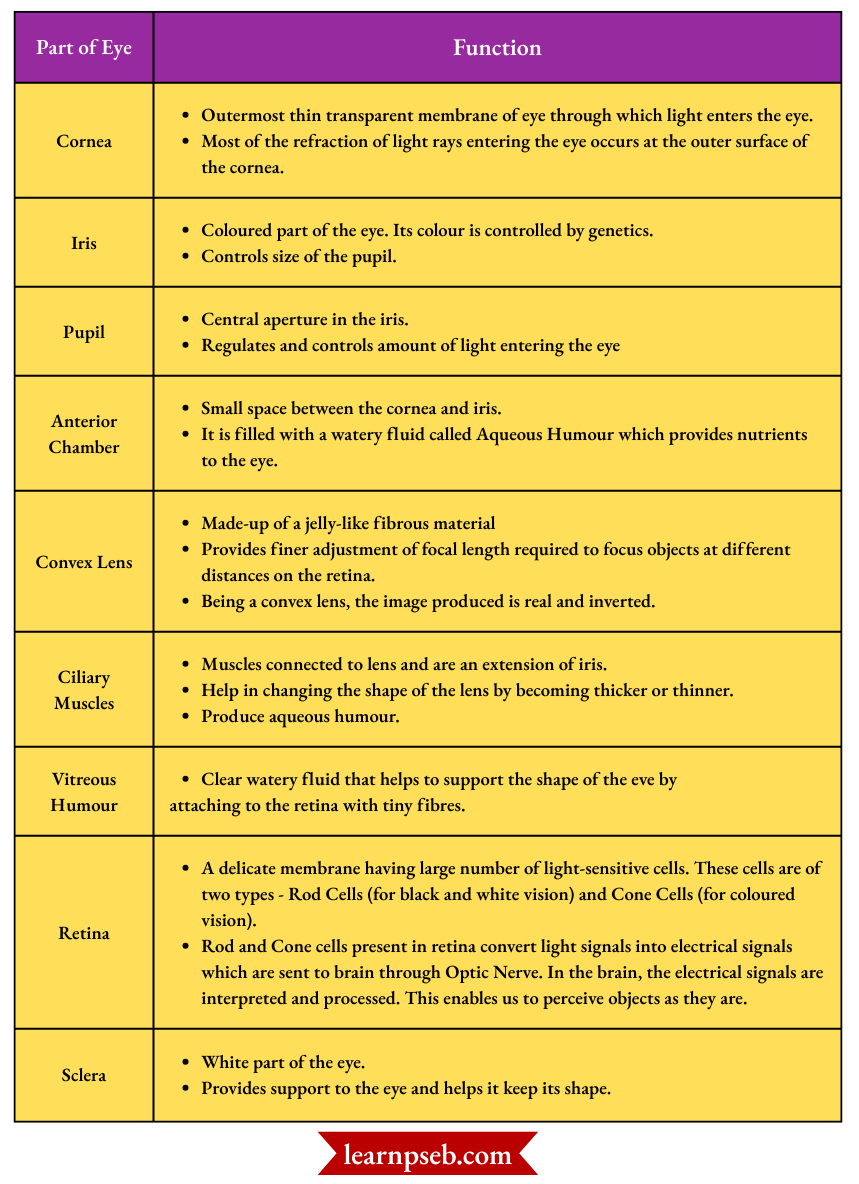
Functioning Of The Human Eye
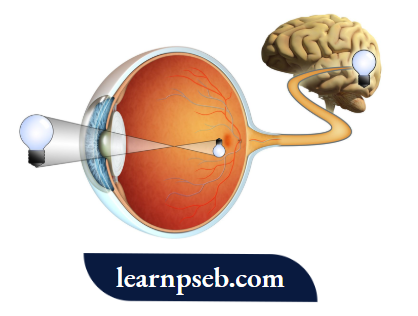
- Light reflected by an object enters the eye through the cornea, and then passes the pupil.
- The convex lens in the eye contracts or relaxes to focus the light onto the retina. Light is refracted as it passes through the convex lens. This causes the image that hits the retina to be reduced in size and flipped upside down.
- Light-sensitive cells (rod and cone cells) present in the retina gather information and send electrical signals to the brain via the optic nerve.
- Cells in the visual cortex of the brain flip the image from the retina, turning it the right way round.
PSEB Class 10 Physics Solutions Chapter 2
Pupil Reflex
The change in size of the pupil to control the amount of light entering the eye is called the pupil reflex.
Pupil reflex is initiated with the detection of the brightness of light entering the eye by the retina. It then passes an impulse to the brain through sensory neurones, the brain interprets the impulse.
and send back a message to the muscles of the iris through motor neurones, triggering a response, the change in size of the pupil due to contraction of radial or circular muscles. This is done to protect the eyes from damage.
Thus, in bright light, pupil size is reduced as too much light falling on the retina could damage it.
In dim light, pupil size is increased to allow as much light as possible to enter the eye.
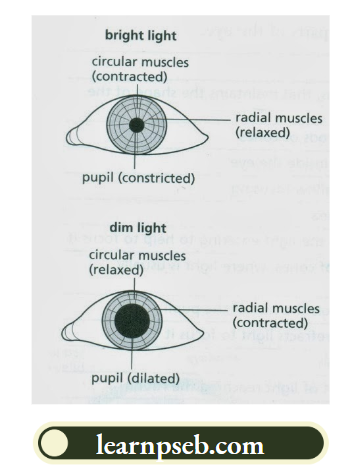
Important Note for Students – Do not confuse the function of circular muscles and ciliary muscles. Remember that:
- Circular muscles affect the size of the iris
- Ciliary muscles affect the shape of the lens.
Power Of Accomodation
The ability of the eye lens to adjust its focal length to some extent by changing its curvature with the help of ciliary muscles is called accommodation. The amount of focusing needed by the lens depends on the distance of the object being viewed. Light from near objects requires a more convex lens than light from distant objects.
- For seeing Close Objects, ciliary muscles contract (Remember this using mnemonic CCC, meaning Ciliary muscles Contract for Close Vision). Due to this, the curvature of the eye lens increases, and it becomes thicker. Consequently, the focal length of the eye lens decreases. This enables us to see nearby objects clearly.
- For seeing Distant Objects, the ciliary muscles relax. Due to this, the curvature of the eye lens decreases and it becomes thin. Consequently, the focal length of the eye lens increases. This enables us to see distant objects clearly.
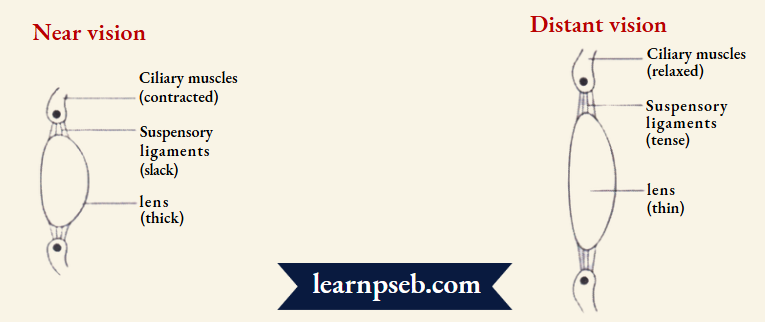
Near And Far Point
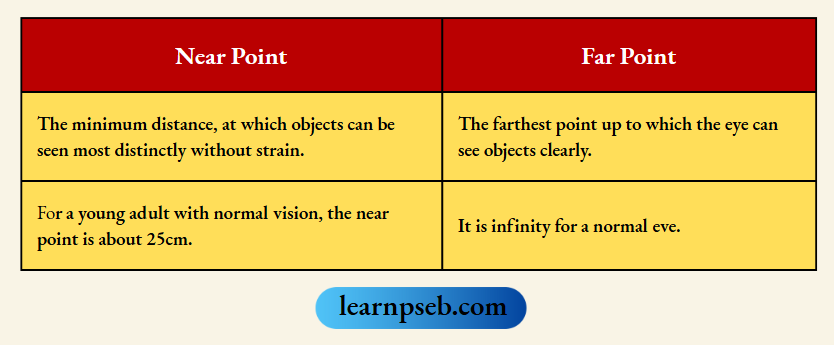
Thus, a normal eye can see objects clearly that are between 25 cm and infinity.
Why Do We Have Two Eyes For Vision And Not Just One?
- It gives a wider field of view. A human being has a horizontal field of view of about 150° with one eye and of about 180° with two eyes.
- Two eyes also provide a better detection of objects.
Note:
- Our two eyes are positioned on the front of our heads. This reduces our field of view in comparison to animals having their two eyes positioned on opposite sides of their heads.
- Each of our eyes sees a slightly different image because our eyes are separated by a few centimetres. The two images are combined into one by our brain, using the extra information, to tell us how close or far away things are.
Refractive Defects Of Vision And Their Correction
Refractive defects of vision occur due to partial loss of the power of accommodation of the eye.
Three common refractive defects of vision are – Myopia (Near-Sightedness), Hypermetropia (Far Sightedness) and Presbyopia.
The Human Eye And The Colourful World PSEB Class 10 Notes

Alternative ways to correct refractive defects of vision are:
- Use of contact lenses
- Eye surgery.
Note:
A person suffering from both myopia and hypermetropia requires bifocal lenses for correction. A common type of bifocal lenses consists of both concave and convex lenses, the upper portion consists of a concave lens to facilitate distant vision, and the lower part is a convex lens to facilitate near vision.
Cataract – It is an eye defect that occurs due to ageing. In this defect, the eye lens becomes milky and cloudy due to ageing, resulting in partial or complete loss of vision. This defect can be corrected only through cataract surgery.
Visual Impairment – Visual impairment means damage or malfunction of any part of the eye. It may occur due to damage to the cornea, pupil, eye lens, aqueous humour, vitreous humour, retina or optic nerve.
Eye Donation
Corneal blindness can be cured through corneal transplantation of donated eyes. Important points about eye donation are:
- Anyone can donate eyes, independent of age or sex.
- People using spectacles, or those who have undergone cataract surgery, can also donate eyes.
- People having diabetes, hypertension, asthma and those without communicable diseases can also donate eyes.
- Eyes must be removed within 4-6 hours after death. This is done by trained persons from eye bank at the home of the deceased or at a hospital.
- Eye removal takes only 10-15 minutes and does not lead to any disfigurement.
- The identities of both the donor and the recipient remain confidential.
- One pair of eyes gives vision to up to FOUR CORNEAL BLIND PEOPLE. This is because one pair of eyes has various components, such as retina, cornea, and muscles, that can be transplanted to the corneal blind people to help in retaining their vision.
- Persons having AIDS, Hepatitis B or C, rabies, acute leukaemia, tetanus, cholera, meningitis or encephalitis cannot donate blood.
Refraction Of Light Through A Prism
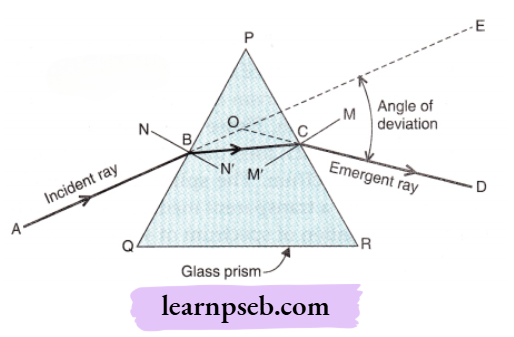
- When light passes from air to the glass of the prism, due to the differences in the refractive index between the air and the glass, light bends once entering the prism.
- Since the sides of the prism are angled, the light bends again when it exits the prism.
- Different wavelengths of light refract differently.
- Longer wavelengths refract less while shorter wavelengths refract more. Therefore, when a beam of white light is passed through a prism, different wavelengths of light get refracted in different angularly in order, resulting in the splitting of white light into a spectrum of seven colours (VIBGYOR starting from bottom) as shown:
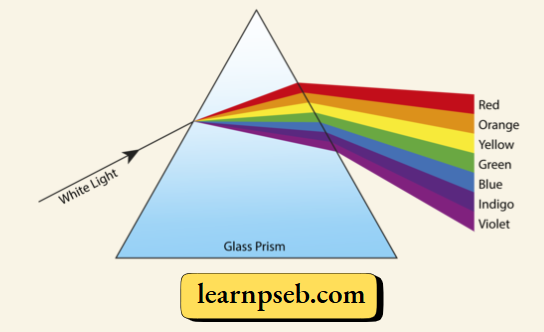
Spectrum – It is defined as an orderly continuum of colours (VIBGYOR) formed due to the dispersion of white light through a prism.
The phenomenon due to which this splitting of white light into a spectrum of seven colours (VIBGYOR) occurs on passing through a glass prism is called DISPERSION.
Rainbow is an example of dispersion of sunlight by tiny water droplets (which act as small prisms) present in the atmosphere.
More About Rainbow
Rainbow is always formed in a direction opposite to that of the Sun.
A rainbow is formed due to three phenomenon – Refraction, Dispersion and Total Internal Reflection of light as shown in figure:
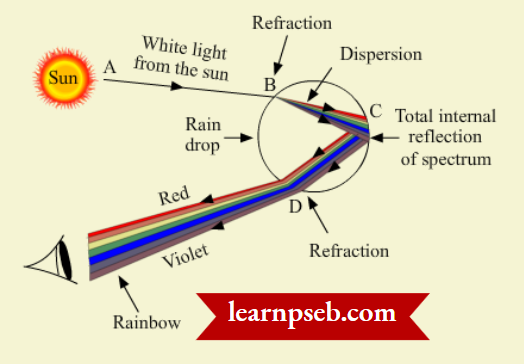
Total Internal Reflection – It is the phenomenon which occurs when the light rays travel from an optically denser medium to an optically rarer medium.
Scattering Of Light – The phenomenon of the spreading of light in different directions by colloidal particles is called scattering of light.
∴ \(\text { Scattering } \propto \frac{1}{\text { wavelength }}\)
Some phenomena that occur due to scattering of light are – the blue colour of the sky, the colour of water in the deep sea, the reddening of the sun at sunrise and the sunset.
Atmospheric Refraction
It is defined as the refraction of light caused by the bending of light rays through different angles on passing through different layers of the Earth’s atmosphere. Some effects of atmospheric refraction are:
1. Apparent flickering of objects placed behind hot air or fire- Air above a hot surface becomes hot and rises up. Its space is occupied by cool air. Since the refractive index of hot and cool air is different, atmospheric refraction occurs, and the object appears to flicker.
2. Stars near the horizon appear slightly higher than their actual position. The density of air decreases with height, i.e., at higher altitudes air particles can spread more, so air is optically rarer at higher altitudes.
PSEB Class 10 Physics Important Questions Chapter 2
Since light from a star coming from the horizon has to travel from an optically rarer to an optically denser medium, it will bend towards normal. As a result, stars appear higher.
Note: Planets do not twinkle because they are much closer to the Earth. Therefore, they nullify the twinkling effect.
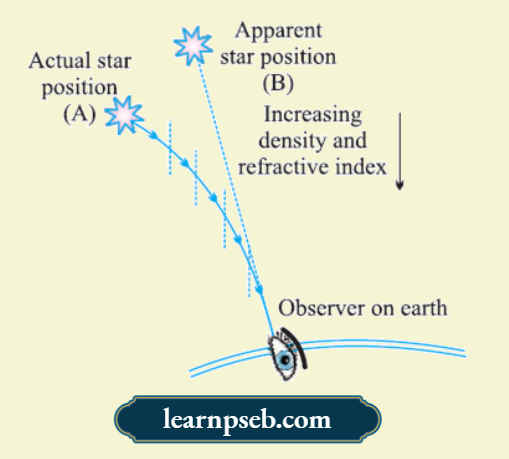
3. Apparent flattening of the Sun’s disc at sunrise and sunset.
4. Advanced Sunrise and Delayed Sunset
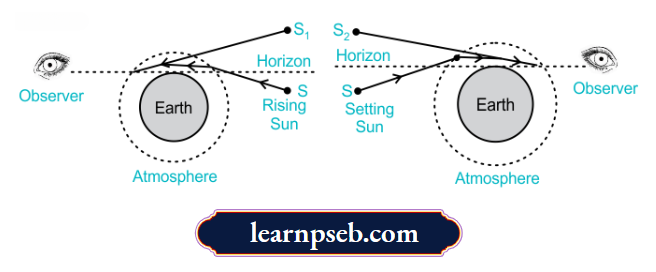
The Sun is visible to us about 2 minutes before the actual sunrise, and about 2 minutes after the actual sunset because of atmospheric refraction.
During Sunrise, the sun is rising above the horizon. The rays from the sun get refracted as they travel from an optically denser medium to an optically rarer medium.
This results in the bending of rays of light towards the normal. Since the human eye sees the sun rays as a straight line, it appears as the sun has risen, though it has actually not yet risen.
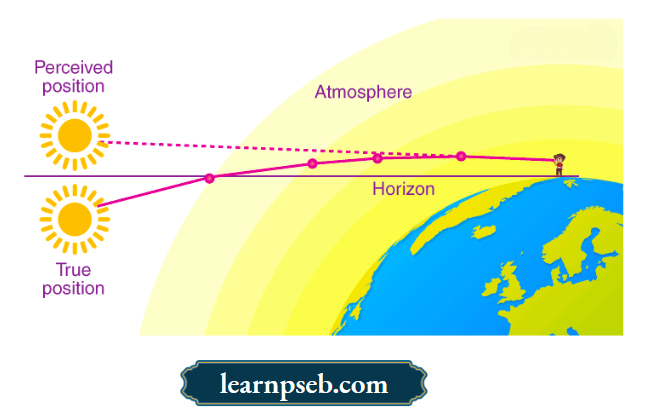
Due to the same reason, the Sun is visible to us about 2 minutes after the actual sunset.
Difference Between Dispersion, Scattering And Refraction
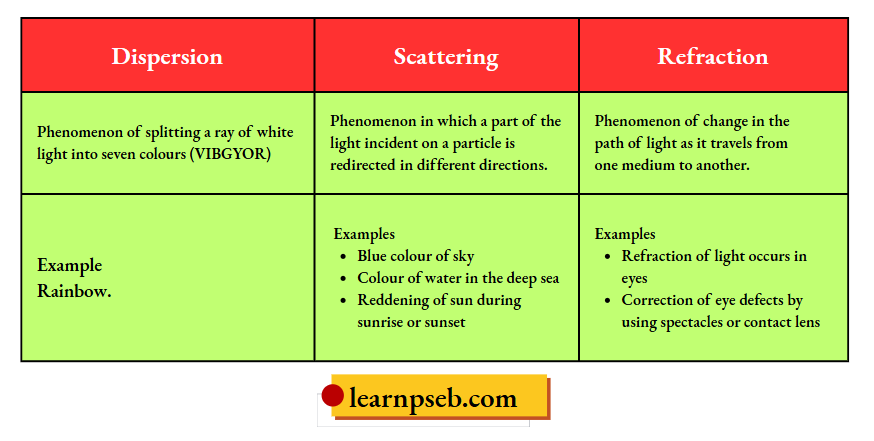
Tyndall Effect
It is the phenomenon of scattering of a beam of light by colloidal particles suspended in Earth’s atmosphere (For Example., smoke, tiny water droplets, dust particles and molecules of air). When a beam of light strikes such fine particles, the path of the beam becomes visible.
Some examples or applications of Tyndall effect in daily life are:
- Scattering of sunlight by tiny water droplets in the mist on passing through a canopy of a dense forest.
- Path of light becomes visible when light enters a dark and dusty room through a slit or ventilator.
The colour of the scattered light depends on the size of the colloidal particles.
1. Very fine particles scatter mainly blue light, i.e., shorter wavelength. Since the upper layers of the atmosphere contain very fine particles of water vapours and gases, these particles are effective in scattering of light of shorter wavelengths, i.e, blue. Due to this reason, if we look at the sky from the Earth, it appears blue to us.
However, skv appears dark to people flying at high altitudes and astronauts due to the absence of particles at such high altitudes, due to which scattering of light does not occur.
2. Particles of medium size mainly scatter red light, i.e., longer wavelength. Therefore, red is the least scattered light.
Since it is not scattered by dust particles and fog, the same colour can be seen up to a long distance. For this reason, danger signs are made in red colour.
3. Very large particles scatter all the wavelengths of light, due to which the scattered light appears white in colour. Clouds appear white because clouds are made up of water vapours which condense to form large water droplets.
Due to the large size of the water droplets, all wavelengths of light are scattered, and the clouds appear white.
Chapter 2 The Human Eye And The Colourful World Reason- Assertion Questions And Answers
For questions given below, two statements are given—one labelled Assertion (A) and the other labelled Reason (R). Select the correct answer to these questions from the codes (1), (2), (3) and (4) as given below.
- Both A and R are true, and R is the correct explanation of the assertion.
- Both A and R are true, but R is not the correct explanation of the assertion.
- A is true, but R is false.
- A is false, but R is true
Question 1. Assertion (A): Sunlight reaches us without dispersion in the form of white light and not as its components.
Reason (R): Dispersion takes place due to variation of refractive index for different wavelengths but in vacuu,m the speed of light is independent of wavelength and hence vacuum is non-dispersive.
Answer: 1. Both A and R are true, and R is the correct explanation of the assertion.
Question 2. Assertion (A): Stars appear to be twinkling and planets do not twinkle.
Reason (R): The blue colour scatters much more than the red colour by air particles.
Answer: 2. Both A and R are true, but R is not the correct explanation of the assertion.
Question 3. Assertion (A): A stick partly immersed in water appears to be bent.
Reason (R): Refraction of light when it passes from water into air.
Answer: 1. Both A and R are true, and R is the correct explanation of the assertion.
Question 4. Assertion (A): In a rainbow, light at the inner surface of the water drop gets internally reflected.
Reason (R): The angle between the refracted ray and the normal to the drop surface is greater than the critical angle.
Answer: 2. Both A and R are true, but R is not the correct explanation of the assertion.
PSEB Class 10 Science Chapter 2 Solutions
Question 5. Assertion (A): The Refractive index of glass with respect to air is different for red light and violet light.
Reason: The Refractive index of a pair of media depends on the wavelength of light used.
Answer: 1. Both A and R are true, and R is the correct explanation of the assertion.
Question 6. Assertion (A): When objects are observed through hot air, they appear to be moving slightly.
Reason (R): The hotter air is optically denser and the colder air is optically rarer.
Answer: 3. A is true, but R is false.
Question 7. Assertion (A): When white light passes through a glass prism, red colour is deviated the least.
Reason (R): Red colour has the minimum speed in the glass prism.
Answer: 3. A is true, but R is false.
Question 8. Assertion (A): The Sun appears white when it is overhead in the sky.
Reason (R): Light coming from the Sun has to travel a relatively shorter distance through the atmosphere to reach us.
Answer: 1. Both A and R are true, and R is the correct explanation of the assertion.
Question 9. Assertion (A): The blue colour of the sky appears due to the scattering of blue colour.
Reason (R): Blue colour has the shortest wavelength in the visible spectrum.
Answer: 1. Both A and R are true, and R is the correct explanation of the assertion.
Chapter 2 The Human Eye And The Colourful World Case Or Source-Based Questions
Question 1. Hypermetropia is a common eye condition where nearby objects appear blurred, but your vision is clearer when looking at things further away. If you feel your eyes are often tired and you have problems focusing on objects close to your eyes, you may have hypermetropia. A person is suffering from hypermetropia (long-sightedness). The near point of the person is 1.5 m. Assume that the near point of the normal eye is 25 cm.
1) The type of lens to be used in his spectacles is
- Concave
- Convex
- Plano concave
- Cylindrical
Answer: 2. Convex
2) The focal length of the lens he should use is
- 20 cm
- 30 cm
- 40 cm
- 50 cm
Answer: 2. 30 cm
3) The power of the lens is
- 2.2 D ;
- 1.1 D ;
- 4.4 D ;
- 3.3 D
Answer: 4. 3.3 D
4) What is another name for Hypermetropia?
- Short-sightedness
- Long-sightedness
- Night blindness
- Presbyopia
Answer: 2. Long-sightedness
5) A The power of a lens is +2.5 D. What kind of lens is it, and what is its focal length?
- Concave lens, 100 cm
- Concave lens, 40 cm
- Convex lens, 40 cm
- Convex lens, 50 cm
Answer: 3. Convex lens, 40 cm
Question 2. The spreading of light by the air molecules is called scattering of light. The light with the shortest wavelength scatters more. The sun appears red at sunrise and sunset; the appearance of blue sky is due to the scattering of light. The colour of the scattered light depends on the size of the particles. The smaller the molecules in the atmosphere, scatter smaller the wavelengths of light. The amount of scattering of light depends on the wavelength of light. When light from the sun enters the Earth’s atmosphere, it gets scattered by the dust particles and air molecules present in the atmosphere. The path of sunlight entering the dark room through a fine hole is seen because of the scattering of the sunlight by the dust particles present in its path inside the room.
1) To an astronaut in a spaceship, the colour of Earth appears
- Red
- Blue
- White
- Black
Answer: 2. Blue
2) At the time of sunrise and sunset, the light from the sun has to travel.
- Longest distance of the atmosphere.
- Shortest distance to the atmosphere
- Both (1) and (2);
- Can’t say
Answer: 1. Longest distance of the atmosphere
3) The colour of the sky appears blue, which is due to the
- Refraction of light through the atmosphere
- Dispersion of light by air molecules
- Scattering of light by air molecules
- All of these.
Answer: 3. Scattering of light by air molecules
4) At the time of sunrise and sunset
- Blue colour is scattered, and red colour reaches our eyes
- Red colour is scattered, and blue colour reaches our eyes
- Green and blue are scattered, and orange reaches our eyes
- None of these
Answer: 1. Blue colour is scattered and red colour reaches our eye
5) The danger signs are made red in colour, because
- The red light can be seen from the farthest distance
- The scattering of red light is the least
- Both (1) and (2)
- None of these
Answer: 3. Both (1) and (2)
Question 3. Atmospheric refraction is the phenomenon of the bending of light as it passes through Earth’s atmosphere. As we move above the surface of Earth, the density of air goes on decreasing. Local conditions like temperature, etc., also affect the optical density of Earth’s atmosphere. On account of atmospheric refraction, stars appear higher than they actually are; advanced sunrise; delayed sunset, oval appearance of the sun at sunrise and sunset; stars twinkle, planets do not.
PSEB Class 10 Science Chapter 2 Solutions
1) Due to atmospheric refraction, the apparent length of the day
- Increases
- Decreases
- Remains the same
- All of these
Answer: 1. Increases
2) The apparent position of the star appears raised due to
- Atmospheric refraction
- Scattering of light
- Both (1) and (2)
- None of these
Answer: 1. Atmospheric refraction
3) The sun appears oval-shaped or flattened due to
- Dispersion
- Scattering
- Atmospheric refraction
- Cannot say
Answer: 3. Atmospheric refraction
4) The twinkling of stars and the non-twinkling of planets is accounted for by
- Scattering of tight
- Dispersion of light
- Atmospheric refraction
- None of these
Answer: 3. Atmospheric refraction
5) In the absence of an atmosphere, the colour of the sky appears
- Blue
- Black
- Red
- Yellow
Answer: 4. Yellow
Question 4. When white light is incident on one refracting surface of the prism, the light splits up into constituent colours violet, indigo, blue, green, yellow, orange and red. The process of splitting white light into its seven constituent colours is called dispersion. When the dispersed white light is made to fall on a screen, we get a band of seven colours is called the spectrum of white light. Red colour bends the least on passing through the prism, and violet colour bends through the maximum angle on passing through the prism.
image
1) The splitting of white light can be done by
- Fens
- Prism
- Mirror
- None of these
Answer: 2. Prism
2) Which property of light is used by a prism to form a spectrum?
- Reflection
- Refraction
- Dispersion
- Scattering
Answer: 2. Refraction
3) When a red light passes through a prism, it
- Will not split
- Will split into seven colours
- Will split into white colour
- Will split into many different colours
Answer: 1. Will not split
4) The spectrum produced by the white light by a prism is called
- Pure spectrum
- Impure spectrum
- Monochromatic spectrum
- None of these
Answer: 2. Impure spectrum
Question 5. Millions of people in the developing countries of the world are suffering from corneal blindness, These persons can be cured by replacing the defective cornea with the cornea of a donated eye. A charitable society in your city has organised a campaign in your neighbourhood in order to create awareness about this fact. If you are asked to participate in this mission, how would you contribute to this noble cause?
1) State the objective of organising such campaigns.
Answer: The objective of organising such a campaign is to make people aware and realize their duties towards society.
2) List two arguments that you would give to motivate people to donate their eyes after death.
Answer:
- By donating our eyes after we die, we can light the life of a blind person.
- One pair of eyes gives vision to two corneal blind people.
3) List two values which are developed in the persons who actively participate and contribute in such programmes.
Answer:
- It shows the concern for others,
- It also shows responsible behaviour towards society.
